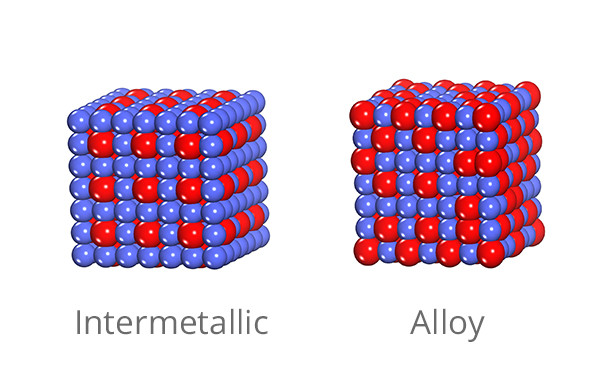
Atoms in an intermetallic are precisely arranged, as opposed to a metal alloy's random arrangement of atoms. This enables researchers to arrange the intermetallic's atoms to create custom catalysts that match specific reactions. IMAGE: MICHAEL JANIK/JAMIE OBERDICK
Researchers seek to revolutionize catalyst design with machine learning
Posted on September 18, 2019UNIVERSITY PARK, Pa. — Researchers from Penn State and Carnegie Mellon University (CMU) have received a $1.2 million grant from the United States Department of Energy (DOE) to use machine learning — a form of artificial intelligence — and data science to design more effective catalysts for chemical processing. The grant is part of a new initiative by the DOE to provide $27.6 million in grants for data science research in chemical and materials sciences.
A catalyst is a stable chemical substance that, when added to a chemical reaction, increases the rate of reaction without becoming part of the reaction.
“It is important to recognize how widespread the use of catalysts is,” said Michael Janik, Penn State professor of chemical engineering and principal investigator for the study. “About 90% of chemical products people are using every day, like gasoline and fine chemicals that are in shampoo, are going through some sort of catalytic process before they’re used.”
Janik added that given catalysts’ widespread use, researchers are constantly searching for ways to make the process more cost-effective, more efficient and less wasteful.
“Given this scale, making small improvements — such as using 2% less energy or producing 50% less waste — become major advances,” Janik said. “Maybe we wouldn’t necessarily think about less waste when we buy shampoo or that our gas is now being produced in a slightly more energy-efficient manner, but, for consumers, that drives down the cost. And then, of course, it’s good for our planet because it generates less waste and a more energy-efficient process.”
The study will focus on creating intermetallic catalysts. Intermetallics are compounds with two or more different types of metal atoms that are precisely arranged in a repeating pattern. This arrangement is different than the composition of a metal alloy, where the two metals’ atoms are randomly arranged. Since the intermetallic atomic arrangement is so precise, theoretically, researchers can customize the atom arrangement to the specific reaction it will catalyze.
Janik and Robert Rioux, Penn State Friedrich G. Helfferich Professor of Chemical Engineering and co-principal investigator for the study, have researched the use of intermetallics for catalysis for more than 10 years. Intermetallic catalysts are designed via computer and experimentally tested.
Janik and Rioux note that experimentation to develop better intermetallic catalysts has been mainly trial and error. Often, even if something worked, it was a struggle to understand exactly how the arrangement of atoms connected to the performance of the chemical reaction.
To make intermetallic catalyst research more efficient and effective, Janik and Rioux joined with two other co-principal investigators for the study: Zi-Kui Liu, Penn State professor of materials science and engineering, and Zachary Ulissi, CMU assistant professor of chemical engineering. As a team, they will design an integrated computational and experimental workflow driven by data science and machine learning tools.
Liu contributes computational expertise and a background in phase stability, which measures whether a material’s properties remain stable under synthesis and catalytic conditions. Like Janik and Rioux, Ulissi’s background is in catalysis; however, he brings more extensive expertise in machine learning to the team.
In the study, the researchers will generate a large amount of computational data on intermetallic metal arrangements and their interaction with reactant molecules. Machine learning algorithms will then be used to recognize patterns that match intermetallic metal arrangements to catalyst performance. This will allow for discoveries that simple research observations would not recognize in such a large set of data.
“For us, the machine learning directs the computation, and it even identifies what’s missing from the data set,” Liu said. “It narrows down what you need to find from the experiment. It goes further than what the traditional computational methods can, as it helps design a more efficient experiment, one that will help us fill in the blanks without any guessing.”
Janik said that the machine learning tools, guided by Ulissi’s lab at CMU, will give the team a better way to tune an intermetallic’s atomic arrangement to more precisely fit a specific reaction.
“Essentially, we can search for arrangements of metal atoms in the intermetallic catalyst that will specifically fit a target reaction,” Janik said. “Another important aspect of our project is that we are combining with an experimental group in Rob Rioux’s lab, so it’s not all data science and computation. [Rioux’s] team has an advanced ability to make and test the intermetallics once we design them computationally.”
Along with making new intermetallic catalysts themselves, the researchers hope that other catalyst designers will use the data science and machine learning tools they develop.
“From a research point of view, machine learning offers a new way of doing things that’s very innovative,” Liu said. “We’re enabling a paradigm shift in how you would design an intermetallic catalyst, and we hope it becomes a pattern for others designing catalysts.”
— Jamie Oberdick
